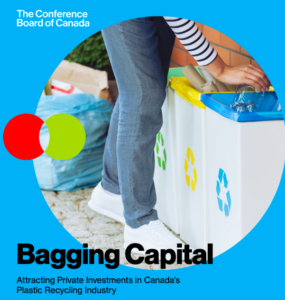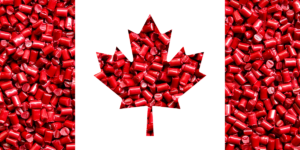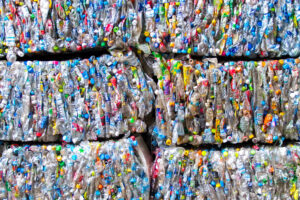- Plastics Marketplace
- National
Producers key to solving plastic pollution problem
Many Alberta communities are lobbying for province-wide EPR legislation for packaging waste
By: Kevin Ma
Look a block south from the Enjoy Centre and you’ll see a busy warehouse in an otherwise empty field. Inside is an example of how we could solve St. Albert’s plastic problem.
The Alberta Beverage Container Recycling Corp. moved to this site from Edmonton back in March, explained president Guy West. Now, about 70 trucks cruise up to its doors every day stuffed full of beverage containers, most of which are plastic – the very substance that’s frustrating so many users of St. Albert’s blue-bag program.
Every bottle, can and Tetra Pak collected at bottle depots in Alberta north of Lacombe finds its way here, where 30 workers empty them from cow-sized mega-bags into compactors, West explained. Once squished into 1,100-pound cube-shaped bales, forklifts load the beverage containers into trucks for shipment to processors.
“These bales are all HDPE (high-density polyethylene),” West said, standing next to a stack of crushed milk jugs taller than he is, and they’re valuable. He gets calls from about four people a month who want to buy these blocks to use in furniture, tools, pallets and more milk jugs. The glass, paper and metal this facility collects also have ready buyers.
“We produce some of the cleanest aluminium shipped into the recycling market,” he said.
“Once it leaves our plant, within six weeks it’s probably back on retail shelves.”
Waste is a resource, and if it’s properly sorted, you can sell it. Experts say one of the best ways to turn plastic waste into wealth is to bring in extended producer responsibility (EPR) – the organizational principal behind Alberta’s bottle depot system.
The blue bag blues
Right now, most Alberta communities run local recycling programs funded by local taxpayers. That creates two big problems.
The first is scale. Major international markets like China have ramped up their sorting requirements to levels municipalities can’t meet without massive investment in sorting technology, explained Christina Seidel of the Recycling Council of Alberta. That investment can only be justified if you have massive volumes to sort and sell – far more than a local program can muster. Many communities – St. Albert included – have instead made big cuts to what their recycling programs accept, frustrating residents and causing waste diversion rates to plunge.
The second is accountability. Blue-box programs make taxpayers pay for waste, which means manufacturers have no incentive to avoid making waste, said Jeff Linton, president of the Beverage Container Management Board (BCMB, which oversees the bottle depot system in Alberta). The result, say industry analysts, is a waste stream stuffed not only with high volumes of material but also hard-to-process items like Styrofoam, plastic wrap and plastic-coated cups.
What is EPR?
EPR is a policy that puts the cost of managing a product at the end of its life onto the producer instead of government, said Allen Langdon, past managing director of Recycle BC and current president of B.C.’s beverage container stewardship group. This usually means industry sets up a system to handle a waste stream and chips in the cash to run it.
While there are voluntary EPR systems out there – the Green Deal packaging return program at London Drugs and the farm plastic program run by Cleanfarms, for example – many are legislated. Alberta has legislated EPR programs for beverage containers, electronics, paint and used oil, while B.C. has one for packaging (glass, plastic, metal and paper) and a long list of other items.
Alberta’s beverage container program came out of the 1972 Litter Act, said West and Linton. Tired of people tossing cans and bottles out of car windows into ditches, politicians passed a law that made manufacturers responsible for their empties and created a two-cent deposit to encourage people to bring them in.
That law evolved into today’s Beverage Container Recycling Regulation, which requires all beverage producers to register their containers with the BCMB, reuse or recycle those containers, and use and maintain a common collection system for such containers, or face fines of up to $500,000.
B.C.’s EPR for packaging program started in 2011 when the province passed regulationsrequiring anyone who sold packaging to meet mandatory government-approved waste reduction targets or face fines of up to $200,000.
In 2014, packaging producers decided to meet their targets by pooling their resources and forming a non-profit called Recycle BC. Using tens of millions in industry cash, Recycle BC now runs a provincewide recycling program that includes both depots and curbside service and accepts a wide variety of materials – many of which (e.g. plastic wrap, clamshells, coffee pods) are not recyclable in St. Albert.
Why it works
EPR shifts costs off cities and onto producers and consumers. That’s important, Seidel said, because as soon as producers have to foot the bill for waste, they suddenly become very interested in reducing that waste.
“That’s the holy grail,” she said, as it can lead to more sustainable product design.
Whenever a company wants to sell a new bottle in Alberta, for example, the BCMB figures out how much it would cost to recycle it and tells that to the company, Linton said. The company then decides if it can bear that cost or if it needs a different design that’s cheaper to recycle. It then pays that fee (typically tacking it onto the price of its drinks), the cash from which runs Alberta’s bottle depot system.
“The difference there is it’s the consumer paying, not the taxpayer,” Linton said – if you don’t buy the drink, you don’t pay for its recycling. (Note that this fee is not the same as the deposit you get for returning bottles.)
Recycling costs are often minimal when spread across whole industries. Linton said the average cost to recycle a container in Alberta was 2.4 cents, for example, while Langdon said recycling costs for packaging in B.C. were often less than a cent per unit – so low many producers don’t bother raising their prices.
This cost shift can save cities a bundle. The City of Vancouver no longer has to spend $4 million year running a recycling program because Recycle BC does it for them, said Albert Shamess, director of zero waste for the City of Vancouver. What’s more, Recycle BC has the resources needed to take in products Vancouver could not afford to accept on its own, which helps the city’s waste diversion efforts.
“From my perspective, there’s really been no downside for the city,” he said.
EPR gets results. Recycle BC now recovers about 78.1 per cent of all packaging material that hits the streets in the province, said spokesperson David Lefebvre – just above their 2022 target of 78 per cent. Of that material, 87.3 per cent gets recycled, about three per cent is turned into engineered fuel and eight per cent is landfilled.
Likewise, Alberta’s combination of a deposit plus mandatory industry participation has resulted in a 92-to 93-per-cent return rate for beverage containers, Linton said, all of which are reprocessed into new products.
EPR creates consistency. Before 2014, B.C. residents were often confused and frustrated with recycling because every community had different rules on what they would and would not take, Lefebrve said. Confused residents mean more contaminated loads and less marketable recyclables. Now, Recycle BC has one set of rules for the whole province and an extensive public education campaign to make sure everyone knows them. That’s resulted in very pure streams of recyclables that are easy to sell.
EPR creates volume and opportunity. Because Recycle BC had all the plastic waste in the province, it was able to promise recyclers that it would provide that material to local companies, Lefebvre said. That produced the economies of scale Merlin Plastics needed to invest $20 million in 2014 into a high-tech recycling plant that now handles all the containers in B.C.
Similarly, West said Vitreous Glass in Airdrie started up because Alberta’s depot system had all this ready-to-use glass on hand. Merlin Plastics likewise built a polyethylene recycling plant in Calgary in the 1990s to take advantage of all the plastic bottles being collected.
All this investment means more jobs. Linton said Alberta’s beverage container recycling system alone employs some 3,100 people, including truck drivers, depot workers and administrators.
“We call it a $300-million economy.”
Volume also allows for innovation. Recycle BC is now using its collection network to gather chip and Zip Lock bags to try and figure out how to recycle them, and is wrapping up a similar pilot for squeeze tubes in partnership with Colgate-Palmolive and Unilever, according to its annual report.
Closing the circle
EPR isn’t a panacea. Recycle BC may be recovering close to 80 per cent of packaging waste overall, but is collecting just 42 per cent of plastics, its annual report shows. There are also many common plastic items it doesn’t accept for recycling, including straws, cutlery, blister packs, six-pack rings and cling-wrap.
Seidel said EPR is just one part of the solution to Alberta’s plastic problem. We also need to encourage producers to design products that can be easily recycled, and set minimum requirements for recycled content in new products.
“We need to develop a suite of policies that’s going to lead us to a circular economy,” she said.
Such an economy could be lucrative. A recent report to Environment Canada found our economy is currently losing $7.8 billion in plastics a year to dumps and the environment. If Canada seriously ramped up recycling efforts and captured that waste plastic, it could create 42,000 jobs, save $500 million, and avoid 1.8 megatonnes of greenhouse gas emissions a year by 2030.



